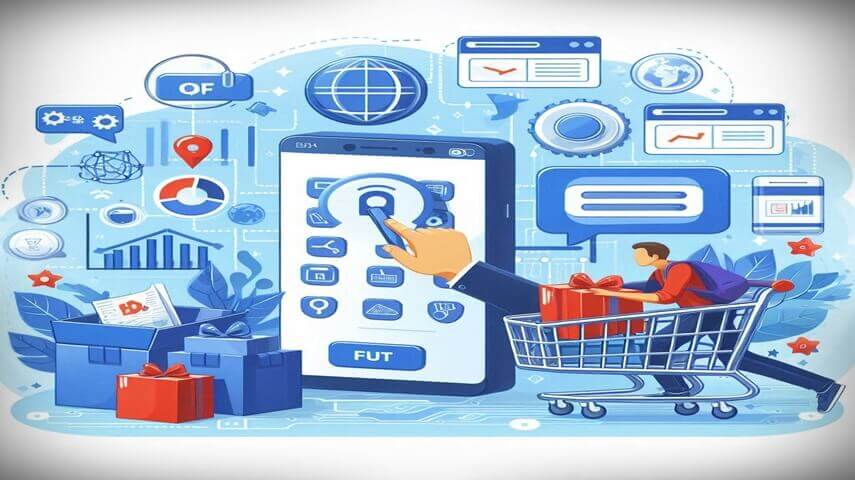Why is the Marketing Strategy in Email Marketing Important?
Digital marketing has practically eliminated traditional forms of customer outreach. There may be a farm supply store somewhere still sending out flyers and converting prospects standing around cracker kegs, but we all attract and woo online shoppers, convert them into online customers, and keep them online.
The most effective forms of digital marketing are Social Media Marketing and Email Marketing.
Both of these approaches can achieve great results, increase customer engagement, and create a lasting flow of conversions. They allow for highly targeted outreach, and in the case of email newsletters, recipients choose to get content, so they are more qualified than the leads you use using other marketing channels.
This article will explain how the views on email marketing. In this article, we will present six marketing strategies in email marketing so that you can improve the performance of your marketing newsletter.
Let’s get into the topic with a quick review of email marketing best practices. This information can help refresh your memory on the basics of email marketing and it will form the basis for the marketing improvement tactics discussed later.
Overview of Marketing Strategy In Email Marketing
There are some of the most common baseline characteristics shared by marketing strategies in email marketing. Before we get into optimization, let’s take a look at a set of best practices that constitute a marketing strategy in email marketing.
Use Email Marketing Services
When your newsletter is up and running, you may be sending content to thousands of recipients each week. Performing that task manually is impossible, and while using email marketing software like Active Campaign is one of the options available, the hours required and in-house expertise make the option less than ideal. Email marketing services are often the best option. There are many providers to choose from, including popular ones like MailChimp and Constant Contact. Such an easy-to-use cloud-based service will help you manage your email list, schedule bulk email deliveries, create forms, and manage responses, plus you’ll have access to analytics that will help you track the performance of your marketing campaigns.
Deliver the Content Your Audience Wants
The people you want to engage with, your prospects, have specific preferences that drive their behavior. The key to delivering content they think is relevant is to learn everything you can about it, which involves defining audience demographics, figuring out what demographic groups they fall into, and tailoring your content for those groups.
Personalize Your Message
Create an email with customizable fields so you can automatically fill in the recipient’s name. If your email is addressed to as an example “Dear customer” instead of the recipient’s name, there’s a high chance it will end up in the trash. Your opt-in form must collect a username; use that info to personalize the messages you send.
Focus on Conversions
In email marketing, there is a great emphasis on getting your emails opened and read. That’s why we test subject lines, improve message content, and track email open rates as a metric. Another thing that gets a lot of attention is the click rate, the number of times the recipient clicks the email to the page you want them to go to. It’s an important factor in email marketing, but it’s a few steps that are removed from the end game, conversion. Ultimately, you want the recipient to respond to your CTA (Call to Action). Keep your message short, specific to your landing page campaign and clear CTA.
Make Your Emails Visually Appealing
It’s important to grab your subscribers’ attention when they open your email. Fortunately, email lets you take advantage of all the capabilities of HTML design. That’s why most of the marketing emails we get look more like web pages than emails. Optimized with background images, custom fonts, eye-catching graphics, and other forms of rich content, your emails can be just as visually appealing as your landing page and your entire site. In fact, having the same look and feel to your email and website adds continuity, creating a better user experience.
GDPR Compliant
If your marketing email will serve anyone in the EU, it must be GDPR compliant. The GDPR, or General Data Protection Regulation, is a government regulation that requires websites serving the EU to be secure and follow defined ‘data privacy violations’ protocols. If you send newsletters or other marketing emails to an EU audience, you need to ensure that you are GDPR compliant, which means having a comprehensive privacy policy and being able to prove that you have the user’s consent to send emails. There are several other GDPR requirements, so if you are marketing to the EU, make sure you know and follow all the rules.
Even if you have had several successful campaigns, you can’t lose to review email marketing basics like this one. This can help keep your focus where it needs to be, plus, following these practices can be considered a prerequisite for the marketing strategy optimization techniques in email marketing that we’ll cover next.
How to Improve Your Email Marketing Strategy
In this section, we’ll present six general ways to optimize your email marketing strategy, starting with the often heard but rarely understood suggestion that your email should “tell a story.”
1. Be a Storyteller
Storytelling is a core principle of customer engagement. People will respond better to your campaign if you present a concept that matches their interest in your product or service.
For many business owners, the idea of storytelling in an email newsletter is confusing. How can you tell a short and compelling content marketing “story”?
The key is to change your thinking about what the story is about. In email marketing, a story is a narrative that describes what it takes and eventually has the product or service you offer.
Believe it or not, this can be done in just a few sentences!
2. Target User Segments to Maximize Engagement
Sending emails that are specifically designed for a specific group of users is called segmentation. This is yet another way to use information about your target audience to predict the most relevant and most interesting types of content.
When you get users to opt-in to your email newsletter, you have the opportunity to ask them about their preferences or, more directly, find out how your offer interests them. You can find out what kind of information users want to receive the most. In the welcome email or at any time after the user has subscribed, you can request the details you need by inviting the user to complete the user profile.
It’s important to know that user segments don’t have to be based on preferences that users tell you. Segmentation by demographics and purchase history is common and can be very helpful. Also, sending targeted emails that are triggered by specific customer behaviors has proven to be very effective.
For example, you could have an email destined for people who didn’t open your first email, and another email designed for people who clicked through to your landing page but didn’t respond to your CTA.
In the first case, prospects may need proof that your company can be trusted. Following up on neglected emails with testimonials can help build trust in your business. In the second case, the user makes it further down your sales funnel but doesn’t buy. Such prospects may just need more details or a compelling story to convince them to take advantage of your offer.
3. Consider Delivery Time & Frequency
How often you email subscribers and when they arrive in their inboxes can have a huge impact on campaign performance. Your customers may prefer a predictable email schedule but receiving messages every day may be overwhelming, and weekly messages that arrive at 9:00 a.m. every Monday are likely to be ignored due to more pressing issues.
To find out how often subscribers want to receive your email, you can add a section to the footer of your email asking them to provide that information via a link to their user preferences.
When determining the best days and times to send marketing emails, there are some reliable statistics you can use. For example, there is strong evidence that emails sent on Saturdays or Sundays will not perform as well as those sent on weekdays, with Tuesday being the best day to send email. The time of day is also important; data shows that emails sent between 10:00 and 14:00 will get the best results.
Another good way to determine optimal delivery times is through testing, which we’ll cover in the next section.
4. Perform A/B Testing to Improve Subject Line, CTA, Delivery Time
Data about how many recipients opened your email and how many clicked to your landing page is very important when comparing the performance of two versions of an email.
A/B testing is a way to let users tell you what works best in your marketing emails. By splitting the recipient list in half and sending “Version” of the email to one half and “Version B” to the other half, you’ll be doing an A/B test. The results will tell you which emails received a better response, and you can use that information, along with additional A/B test results, to gradually refine your content until it’s exactly what your audience wants it to see.
You can use this type of analysis to optimize several aspects of your email, including subject lines, CTAs, delivery times, and more. However, you should only test one thing at a time. If an email with a subject line A is sent at noon and another version with a subject line B goes out at 3:00 p.m., when one email gets a better response, you won’t know if the performance increase was due to the subject line or the send time.
If you A/B test your email elements one at a time, you’ll be able to pinpoint the exact subject line, CTA, and delivery time to give you the best response.
5. Don’t Let Your Email Be Filtered As Spam
Every email service has features to protect users from spam. They use spam filters to flag and remove suspicious emails that may be a mechanism for distributing malware or being used as part of a scam. If the spam filter incorrectly marks your message as spam, most of your audience will never see your newsletter.
One important step you should take in keeping your emails out of the recipient’s Spam folder is to avoid using ‘sales’ language. Spam filters use sophisticated algorithms that scan your emails for the types of content often found in spam emails. You should avoid using all capital letters, three exclamation points, and words like “free”, “bonus” or “sale”. Also, leave out classic sales phrases like “Act now!”
Another effective way to keep your email from being mistakenly identified as spam is to be whitelisted, that is, to be added to a user’s list of pre-approved email senders. At the bottom of your email, you can casually make a request, perhaps taking advantage of FOMO (fear of missing out), the user’s fear of missing out or the fear of missing out on an opportunity. If your users find the content relevant to their interests, chances are they won’t want to miss out.
6. Measuring Results to Reveal Opportunities for Improvement
We covered A/B testing, but it focused more on the top of the sales funnel than the bottom. Email open rates and click-through rates are critical in changing the first steps of prospecting, but customer behavior over time can give you a better overall picture of campaign performance, revealing areas for improvement.
Post-campaign analytics can also expose new customer segments to the target. For example, if you track the number of people who have opened at least one of your emails in the last 30 days, you will end up with a list of active subscribers and inactive subscribers. To maximize engagement, you need to send both groups of very different messages. Without taking a long-term view of the marketing strategy performance data in your email marketing, you will never be able to take advantage of such segmentation opportunities.
Once you have campaign results data that reveals customer behavior over time and exposes the true impact of your email on sales, you can take the opportunity to overhaul your approach before starting a new campaign.
Improve the Performance of Your Marketing Strategy in Your Email Marketing
Email marketing is effective because it targets people who, as customers, are qualified prospects, fully prepared to use your content and make a purchase.
Goes beyond basics like using an email marketing service; To send personalized, relevant content and keep the focus on conversions, there are several ways to tweak your email newsletter to maximize its effectiveness. Engaging your audience with engaging stories, dividing recipients into segments, testing your content and avoiding spam filters, for example, can have an immediate impact on your campaign.
It is hoped that this coverage of marketing strategy optimization techniques in email marketing will help you create better content for your newsletter subscribers and improve the performance of your next marketing campaign!




